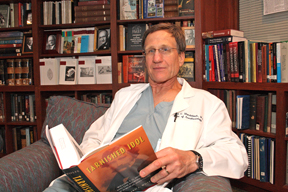Organization and attention to detail are important traits for professionals. For anesthesiologists, they’re not only qualities essential to success, they’re a matter of life and death.
 |
| Mark Mandabach was recently awarded the Rod Calverley Fellowship by the American Society of Anesthesiology’s Wood Library-Museum of Anesthesiology. |
Mark G. Mandabach, M.D., assistant professor of anesthesiology, says his history teacher in the seventh grade, Robert Peterson, was one of the first to show him the importance of striving to possess those traits. It was through the study of a letter a Civil War soldier sent home to his family moments before he died that the instructor demonstrated the importance of fact-checking, double-checking and research. The soldier proofread his letter, making corrections as he lay on the battlefield, mortally wounded.
“Mr. Peterson actually made us sign a statement when we turned our work in that said, ‘I have proofread this report,’” says Mandabach. “He gave that as an example to stress how important it was to proofread your work and make sure it was correct. I still have a couple of those reports in a file at home.
“There’s a tremendous attention to detail in scholarly work and history, and there’s certainly much attention to detail and organizational skills in anesthesiology and the practice of medicine,” he says. “They really all go together.”
Those two qualities have helped Mandabach earn his recent selection as UAB’s first Rod Calverley Fellowship award winner. The fellowship is one of several awarded each year by the American Society of Anesthesiology’s Wood Library-Museum of Anesthesiology and is its most prestigious. Mandabach is the third member of the UAB Department of Anesthesiology to win a Wood Fellowship, joining J. Antonio Aldrete, M.D., and A.J. Wright, director of its David Hill Chestnut, M.D., Section on History of Anesthesia.
“It’s quite an honor to be selected, however, I think it’s a reflection on our anesthesia history section here at UAB,” Mandabach says. “I’ve had a tremendous amount of help from the section and support from people in the group, from A.J. Wright, R.J. Defalque, M.D., J. Antonio Aldrete, M.D., Maurice S. Albin, M.D., and Jason McKeown, M.D. It’s really because of them that I pursued the fellowship.”
Mandabach plans to use his fellowship to research the history of anesthesia in Alabama and its impact on the history of the UAB Department of Anesthesiology. The department will be celebrating its 60th anniversary next summer, which also happens to coincide with the founding of the Alabama State Society of Anesthesiologists; so the timing of the award is perfect, he says.
“The assumption is that there is much about the history of anesthesia on a state level that really hasn’t been explored and needs to be,” Mandabach says. “Mr. Wright has done some work on it, but that’s about it. We’re hoping to look at our roots and assess where we came from, where we are today and consider the direction that the future holds for us.”
Mandabach says such state-level histories are rare. He says there is a book-length history of anesthesia in Oregon and articles on anesthesia history in a few other states such as Ohio and Indiana. He doesn’t know the full number of these histories/partial histories at the state level. Part of the project will involve determining that landscape.
The fellowship will enable Mandabach to travel to the Wood Library-Museum of Anesthesiology (WLM) to conduct research for up to 15 funded days. The WLM ranks among the world’s premier collections devoted to anesthesia history. Housed in the headquarters building of the American Society of Anesthesiologists in Park Ridge, Illinois, the WLM also is an active, specialized medical library. Mandabach estimates it will take around two years to complete the project.
The Rod Calverley Fellowship is jointly supported by the department of anesthesiology at the University of California at San Diego in memory of Calverley, who was a member of that department. Calverley was a strong advocate of anesthesia history studies and one of the founding members of the Anesthesia History Association who initiated the WLM’s fellowship program.
Mandabach says he’s been interested in anesthesia history since his first year of residency when one of his professors, Merlin Larson, sent him to the library to look up an article on J. Leonard Corning’s work with spinally administered cocaine hydrochloride, the first local anesthetic.
“He sent me over to look for the article but he gave me the wrong reference so I came back with something different from than what he wanted,” he says. “I always wondered if he didn’t maybe do that on purpose to get me to go back on my own and look around.
“I spent hours on my own in the basement of the medical library looking through old journal articles,” he remembers. “When I graduated from my residency at UCSF, Dr. Larson took me on a surprise tour to the resting places of F. Dudley Tait and Guido Caglieri, two San Francisco physicians who performed the first spinal anesthetic in the United States. I did not know where we were going until we got there.”
UAB’s Section on History of Anesthesia, established in June 2002, was the first such academic unit in the world.